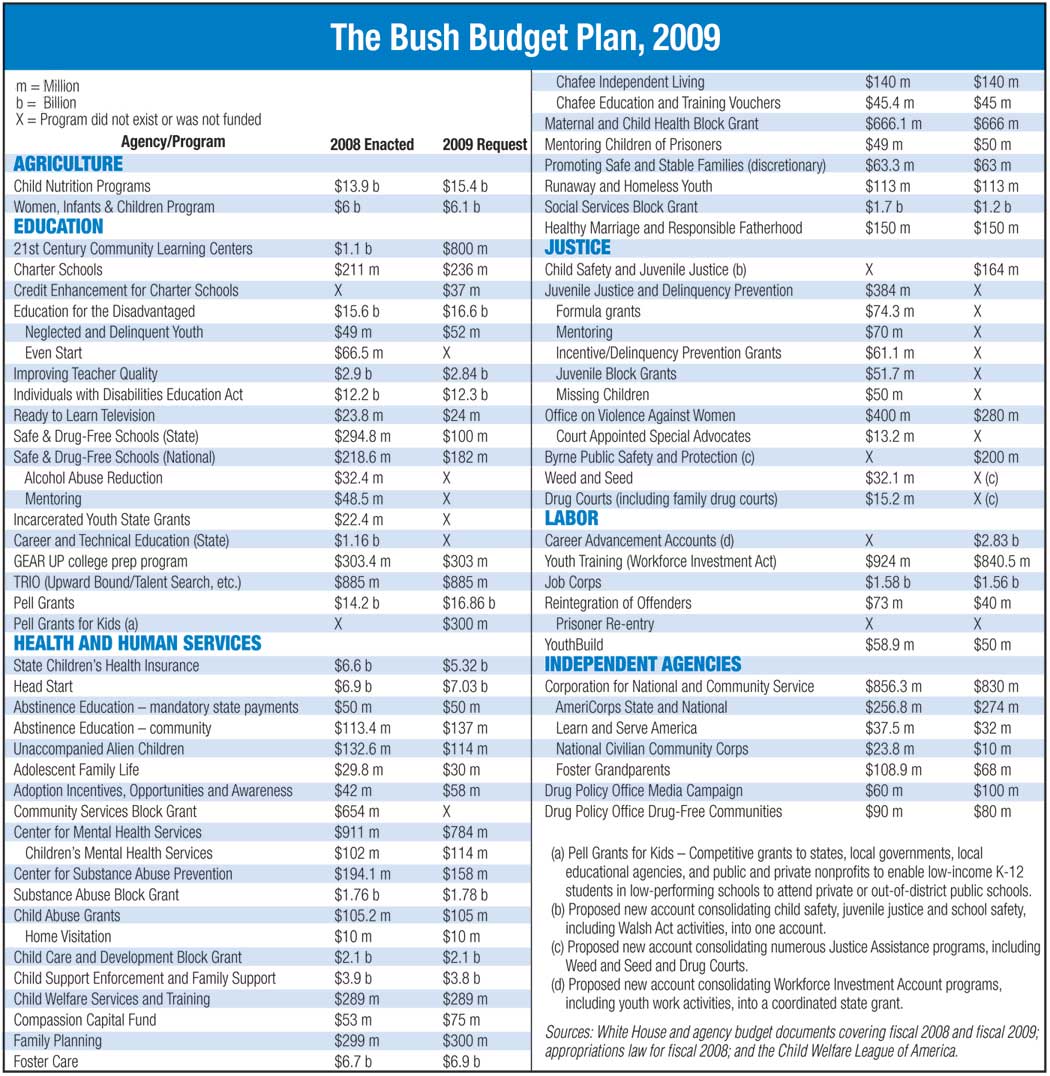Just weeks after Congress enacted a fiscal 2008 appropriations law that some youth advocates viewed as short-changing many kids’ programs, they were hit with another whammy: President Bush’s $3 trillion budget proposal for fiscal 2009, which shaves after-school initiatives, drug prevention and foster grandparenting, and leaves flat or eliminates many other youth programs.
 The youth field isn’t exactly shuddering, however; the plan is unlikely to be enacted. This is Bush’s final year in office, so “it probably is not his most influential budget,” said Michael Linden, director of tax and budget policy with First Focus, a bipartisan youth advocacy organization.
The youth field isn’t exactly shuddering, however; the plan is unlikely to be enacted. This is Bush’s final year in office, so “it probably is not his most influential budget,” said Michael Linden, director of tax and budget policy with First Focus, a bipartisan youth advocacy organization.
The proposal is only the opening move in a months-long appropriations process that Congress technically is required to complete before Oct. 1, but which recent history suggests will last into next year.
Linden said Bush’s proposal recommends $2.8 billion in net cuts in programs that affect children, which would mean a 3.1 percent decline from this year’s federal budget.
After School
 Bush would cut $300 million from 21st Century Community Learning Centers, leaving the program at $800 million, and convert it into an after-school and summer scholarship program, which would “voucherize” it, said Miriam Rollin, vice president of Fight Crime: Invest in Kids. Vouchers make little sense for after-school programs, she said, because many underprivileged communities lack the funds to establish high-quality programs. “If there’s no place for them to go, the voucher is worthless,” Rollin said.
Bush would cut $300 million from 21st Century Community Learning Centers, leaving the program at $800 million, and convert it into an after-school and summer scholarship program, which would “voucherize” it, said Miriam Rollin, vice president of Fight Crime: Invest in Kids. Vouchers make little sense for after-school programs, she said, because many underprivileged communities lack the funds to establish high-quality programs. “If there’s no place for them to go, the voucher is worthless,” Rollin said.
Education
The $300 million in Community Learning Centers cuts would be funneled to the new Pell Grants for Kids, providing competitive grants to states, cities, local educational agencies and nonprofits to support vouchers that enable low-income K-12 students in “persistently low-performing schools to attend a private or out-of-district public school,” according to Bush’s proposal. The plan resembles the congressionally imposed District of Columbia Opportunity Scholarship program, which a 2007 Education Department evaluation said did not produce significant gains in achievement in its first year.
enable low-income K-12 students in “persistently low-performing schools to attend a private or out-of-district public school,” according to Bush’s proposal. The plan resembles the congressionally imposed District of Columbia Opportunity Scholarship program, which a 2007 Education Department evaluation said did not produce significant gains in achievement in its first year.
Elsewhere in education, the elimination of Career and Technical Education accounts “surprised us,” said Tom Zembar, senior policy analyst for the National Education Association. The president’s budget proposal said a recent evaluation of the state grants program – which generally funds community colleges – raised questions about its effectiveness in helping prepare high schoolers for the transition to postsecondary education and the work force.
Juvenile Justice
 Resurrected for the eighth straight year is a plan to consolidate juvenile justice funds – including formula money that states use to comply with youth safety protections in the Juvenile Justice and Delinquency Prevention Act (JJDPA) – into a competitive grant of $164 million, which is less than half the 2008 amount of $384 million.
Resurrected for the eighth straight year is a plan to consolidate juvenile justice funds – including formula money that states use to comply with youth safety protections in the Juvenile Justice and Delinquency Prevention Act (JJDPA) – into a competitive grant of $164 million, which is less than half the 2008 amount of $384 million.
“Everything that states are supposed to do under the JJDPA, including supporting the state plans, complying with the core requirements and also developing and replicating innovative new programs around … delinquency prevention … would have to come out of the $164 million,” said Tara Andrews, deputy executive director for policy and programs at the Coalition for Juvenile Justice, which represents governor-appointed juvenile justice advisory groups.
With so little funding, some states may drop out of the JDDPA, which is “certainly what we don’t want,” Andrews said. As the field gears up for JJDPA reauthorization, the president’s proposal could serve as a foil that “helps to support the changes that we are advocating for,” she added.
Child Welfare
Aside from a request to boost adoption incentive funding by $15 million, the 2009 child welfare request is generally unchanged from 2008. And the president wants to eliminate the $654 million-plus Community Services Block Grant, which underwrites programs for vulnerable populations, including at-risk youth, and to cut $500 million from the Social Services Block Grant, an anti-poverty program. These are perennial recommendations that Congress doesn’t follow.
Shadi Houshyar, director for child health and welfare policies with First Focus, said the group will try to educate lawmakers on how kids are affected by cuts “across the board and why this is a sound investment to be made.”
Other Cuts
The following other agencies have programs on the proposed chopping block:
• Corporation for National and Community Service, where the Foster Grandparents program would be reduced by nearly $41 million.
• Office on Violence Against Women, where many programs – including Court Appointed Special Advocates – would be consolidated into a competitive grant and cut by a total of $120 million.
• Labor Department, where the $841 million youth work force training allocation would be subsumed under a proposed Career Advancement Account.
























